
Station Name: YARMOUTH SOUTH TOWNYarmouth South Town Gallery 3:
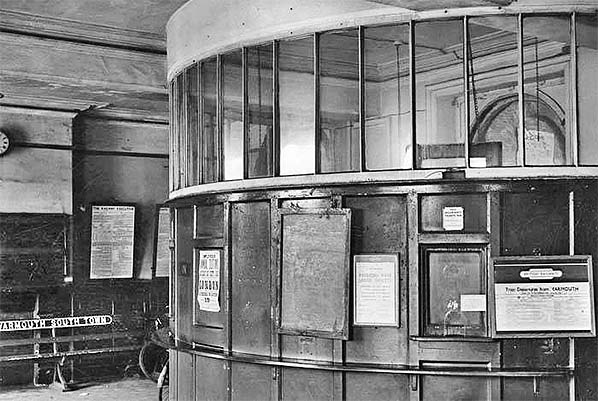
Yarmouth South Town ticket office on 12 September 1950. Located within the booking hall, within the station building, it was separated from the concourse area by the wall seen in the right background. Whilst we must allow for what are now quite old photographs, the station interior was clearly quite scruffy and gloomy. There would, however, been a lack of maintenance during the war, other than repairing bomb damage (as far as is known the station itself was hit only once and the bomb failed to detonate but the signal box and general area around the station received rather more damage). Compared to the other photographs showing the ticket office, on this occasion it was rather more cluttered with notices and other posters. The British Railways board on the right advises potential passengers of 'Train Departures from Yarmouth' but there is no obvious mention of South Town so we do not know if services from Vauxhall - and perhaps Beach - were also shown. Close examination shows the board to be mounted on the ticket office by a bracket, suggesting it contained a roller-type departures list would could be adjusted according to the time of day. Such devices, in varying sizes were once common. In 1952 this rotund ticket office was removed and a Benn & Cronin departures indicator placed against what had been the back wall of the ticket office. The new ticket office was located in the south side of the building, in the area just out of view to the left. Note the nameplate on the bench, left. This would be the type of nameplate which ended up attached, in unauthentic fashion, to the 'fishy themed' bench now on display at the National Railway Museum.
Photo from Andy Barton collection 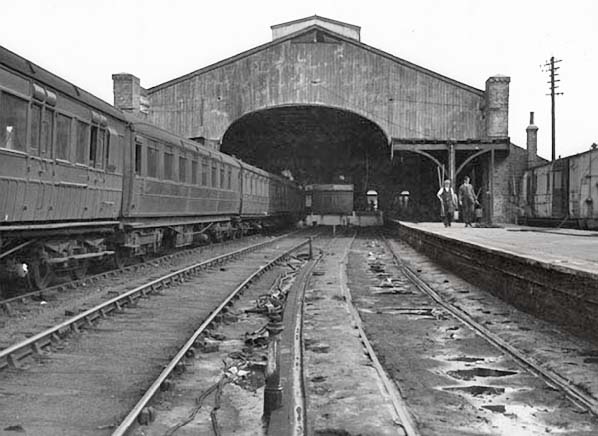
Peering into the gloom that was South Town's trainshed on 12 September 1950. Of interest here are the platform awnings, or their absence. They had been removed by this date with only stanchions supporting the end of the trainshed remaining. This applied to both [island] platforms as the end of the truncated awning on Platforms 3 and 4, left, is just visible above the second carriage. This scene was transformed in 1952 with the removal of the trainshed and installing of new platform awnings. The train at Platform 3 comprises ex-GER and ex-LNER Gresley stock, the introduction of BR Mk1 stock still being a year away. The train has been taken into the platform by a tank locomotive which may be the station pilot or had brought the train from Beccles or Lowestoft. Whatever it was, the locomotive has drawn up to the buffers so will need to await the train's departure so that it can be released. To see anything beneath the trainshed requires lightening of the image but, even when doing this, it is unclear if the points to the centre release road were in situ at this time. On the right and at the buffers of Platform 1 sits the old 6-wheel carriage which seems to have been present for some considerable time. At other times a goods van would be present and either type appear to have been used by station staff for one purpose or another.
Photo
from Berney Arms web site
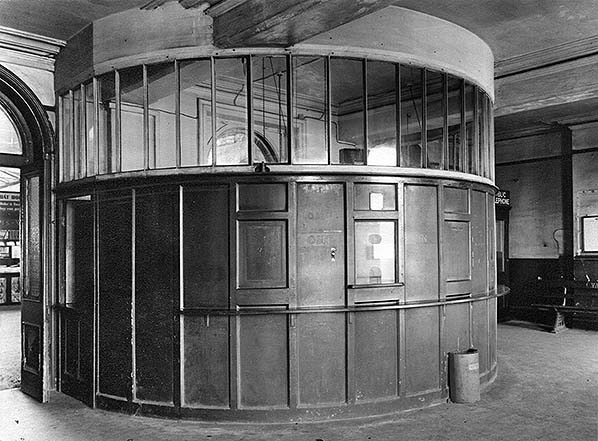
Yarmouth South Town ticket office seen here on 3 October 1950. The office was located in the booking hall (there is a difference between a booking hall and a ticket office) which was the front section of the station building, above which was stationmaster's accommodation. Through the doorway on the left part of the W H Smith bookstall can be seen, a rectangular structure which sits in the middle of the concourse, beyond which were the platforms. Behind the solid section of wall at the back of the ticket office stood a small tobacco kiosk. According to British Railways plans of the 1952 alterations this tobacco kiosk remained in situ as did the W H Smith bookstall. The new ticket office was to be located behind the camera and to the left of passengers as they entered the building from the forecourt. When the ticket office seen here was removed, the arched window behind the office was bricked up and a Benn & Cronin Train Indicator board was mounted this side of the wall but it is not known if it was a new item or a relocation of that which had stood outside overlooking Southtown Road (see picture). Although the general fabric of the ticket office is typical of the nineteenth century, it is not known if this rotund example dated from the station's opening. The upper glazed part and its continuation to the ceiling certainly appear to have been an afterthought. The stable door on the left is the staff entrance and the office has provision for several teller positions although, at this time at least, only one was in use and this becomes obvious from the interior view. Just visible on the woodwork are 'In' and 'Out' signs to the right and left respectively of the teller position, the passenger flow thus corresponding with the station's original Arrival and Departure platform layout. The litter bin was not very well positioned if intending passengers were supposed to queue from the right and especially on a warm day when the bin would likely become rather odorous - a problem with the once common 'open' type little bins which readers above a certain age will remember. To the left of the teller position is a bell push, used to attract the clerk's attention when, during quiet periods, he may be at his desk catching up on paperwork. In 1950 South Town was still a busy station, especially during summer weekends, and just one teller position might therefore appear woefully inadequate. In practice many visitors to Yarmouth would arrive with return or excursion tickets so the situation with the ticket office would not have posed any problems. On the right, and lurking in the gloom in front of the telephone booth, is a bench seat complete with nameplate. It is a standard GER item and not one of the ornate items nodding to the fishing industry.
Photo by British Railways Chief Civil Engineer, King's Cross, and courtesy of Bob Randall 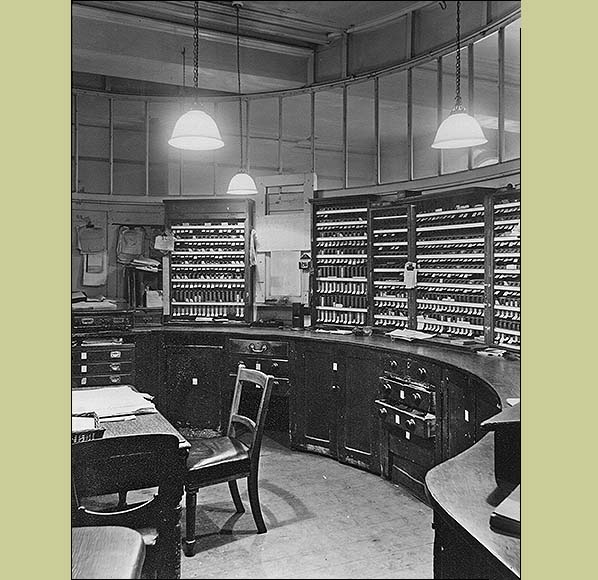
The interior of Yarmouth South Town ticket office also taken on 3 October 1950 despite the calendar claiming otherwise. With the external view it was mentioned that the interior view would make it obvious that only one teller position was in use, thus here is the evidence. The camera is looking in through the stable door seen on the left of the external view. In the days when computers existed only in science fiction and at Bletchley Park or GCHQ a railway ticket clerk's job was very 'hands on', involving much work over and above selling tickets and the office desk can be seen on the left of this view. The various drawers would have contained fare books, ticket route availability lists, timetables and a host of other official papers. It will be noticed that it was not practical for the clerk to sit at the teller position, or at least not comfortably. This was normal for the time as the clerk would need to move along drawing tickets from the various racks seen here. The racks contained what were known as 'tubes', in which tickets were held for specific destinations and of various types. The tickets seen here were of course of the Edmondson type. These were largely pre-printed and when sold would be validated by the clerk by means of the tall, narrow device seen on the counter below the calendar. There were numerous types of ticket; 1st class; 3rd class (until 1956); Single; Return; Privilege; Forces Leave (also known by the LNER as 'Furlough' tickets); Adult; Child; Platform and so on. There were also semi-blank tickets which clerks filled out by hand. These might be used, for example, for obscure destinations for which pre printed stocks were not held. Numerous examples of Edmondson tickets can be seen throughout the ‘Disused Stations’ website. As complex as the system may sound it was nevertheless much simpler and better understood (by railway staff and the public) than it is today. The Edmondson system came into use in 1842 and continued in use in Britain until June 1989, the final station to issue them being Emerson Park (Romford - Upminster line). However, they are still produced for use by heritage railways and the railways of a handful of other countries, mainly in Asia, still use them as of 2017. British Rail, however, was by no means wedded only to Edmondson tickets. Conductor-guards issued a variety of different types of paper ticket according to area and in the 1960s BR introduced a range of large (approx. 6in x 2½in) tickets on which many details were printed at the point of sale. These were the forerunners of the orange APTIS and PORTIS tickets which are now themselves obsolete and have been replaced by fully computerised systems, albeit still on orange cards which makes the differences perhaps not immediately obvious to all-but frequent users of the railways. When a station closed or, as in the case of South Town, became unstaffed, remaining ticket stocks would be sent for accountancy and then either destroyed or sold to collectors for a nominal sum. Many of the surviving unissued tickets were those intended for destruction but which for some mysterious reason never made it to the incinerator. The most prized tickets for collectors were pre nationalisation examples, many of which were still issued by BR, or lingered in BR tickets offices unsold, owing to the journeys they covered being in little demand. When this photograph was taken in 1950 the tickets tubes very likely still contained a number of LNER tickets and possibly some GER examples; when issuing these the clerk would strike out the by-then-invalid fare and apply the relevant fare by hand. It is unlikely that modern tickets will achieve the same collectors’ following as the Edmondsons, in part because line and station closures are now all-but events of the past.
Photo by British Railways Chief Civil Engineer, King's Cross, and courtesy of Bob Randall 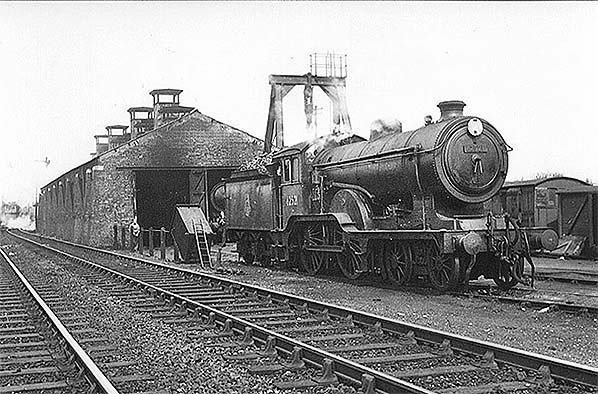 Yarmouth South Town locomotive shed on 19 May 1951. This is the original shed as constructed under the Yarmouth & Haddiscoe Railway Act and which was to stand for just short of a century until total rebuilding in 1956. In the left background is just visible the wartime rendition of South Town signal box, the station being beyond it and obscured from view by the shed. Posing for the camera is a then resident of South Town shed, Class D16 4-4-0 No.62521. New in 1902 as GER Class S46 No.1870 she was from the early batches following on from class doyen No.1900 'Claud Hamilton' which, built in 1900, was to win gold at the Paris Exhibition of that year. Under the LNER No.1870 was classified D14 and in 1935 was given an LNER Diagram 28A superheated boiler which catapulted her into the ranks of Class D16; the designation by which the 'Clauds' became best known. Usually accredited to James Holden, the design was actually largely the work of Fred Russell, Stratford's Chief Draughtsman. Like her sisters, No.1870 underwent several renumberings until becoming LNER No.2521 in 1946 and then in 1949 British Railways No.62521. The form in which No.62521 is seen here is that with which the 'Clauds' are best remembered, perhaps obviously so given the passage of time, but this form bore only a vague resemblance to the original design which was rather more ornate and typical of the late Victorian and Edwardian periods. Dual braked, air and vacuum, No.62521 was to leave South Town in April 1953 and following a spell of being jostled between Cambridge and King's Lynn sheds she was withdrawn from the latter shed in February 1958 and scrapped shortly afterwards.
Photo from Roger Griffiths collection 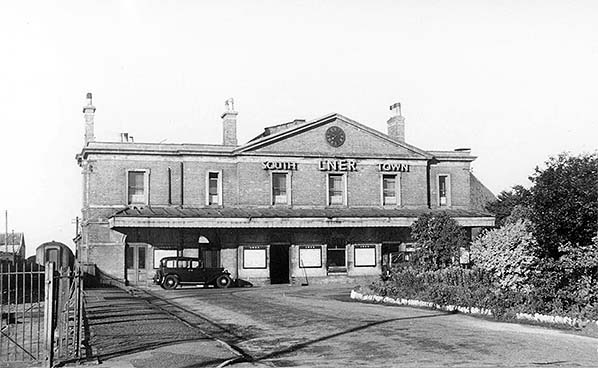
South Town station forecourt in September 1951 and still with its LNER branding which would survive until the following year. The unkempt garden would also survive only until the following year. At this time such unkemptness was somewhat unusual and may have been allowed to occur during the war years. Behind the gate, far left, out one of the tracks which continued across the road into the goods yard can just be made out. On this occasion both tracks appear to have been commandeered for rolling stock stabling. The car is highly suspected of being H C Casserley's well-known 1934 Hillman Minx and, visible under magnification, it still carries white wing and bumper tips - a hangover
from the wartime blackout. Copyright photo
by HC Casserley
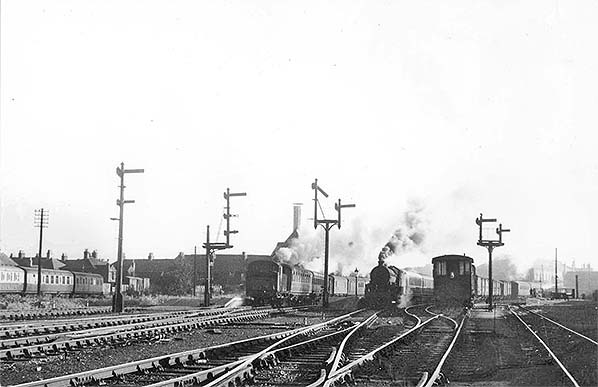
It is shocking to think that less than nineteen years after this photograph was taken, this scene would be one of utter dereliction. This is Yarmouth South Town one morning in September 1951, looking towards the terminus. The locomotive at Platform 3, left, is one or other of the 0-6-0 tanks, possibly a J68, and according to its lamp is on station pilot duty (visible in a larger version of this image) and this would explain the odd train formation; the third vehicle is a goods van and the fourth appears to be an ex-LMS 42ft CCT. Providing the goods van was fitted or through-piped there is no reason such a formation could not run within the speed limit for such vans but non-passenger-carrying stock would not be marshalled in the middle of a rake of corridor passenger stock when in service. The B1, right, which is thought to be No.61001 Eland, is carrying express passenger lamps and given that Platform 1 could accommodate eight bogies, the train is quite lengthy and thus is probably a service to Liverpool Street*. The signal which is 'off' controls Platform 2 and also locomotives which have joined Platform 2 road from the centre release road. What has emerged, or is about to emerge, from Platform 2 is not known. Various types of passenger and goods stock can be seen scattered around in the usual haphazard manner typical of South Town. At far left, the ex-LNER stock comprises two vehicles in BR 'blood and custard' livery while the other would be in painted teak livery. One, that partly visible far left, is a Gresley bow-ender and the Blood & Custard (properly 'Carmine & Cream') livery sat particularly well on these vehicles. In the right background the rarely photographed cattle pens can be seen. The coaching stock in the right background will be the same stock seen in the 1951 view of the station forecourt, the stock being stabled on the roads leading to the goods yard. [*A 1948 timetable shows a departure for Liverpool Street at 8.00 and may or may not be correct for 1951. There was another departure for Liverpool Street at 9.00 and this joined with a portion from Norwich at Ipswich. A working timetable (WTT) from 1954 shows departures for Liverpool Street had changed to 7.30 and 9.43, the latter being loaded to nine bogies and ran all stations to Ipswich].
Copyright photo by HC Casserley 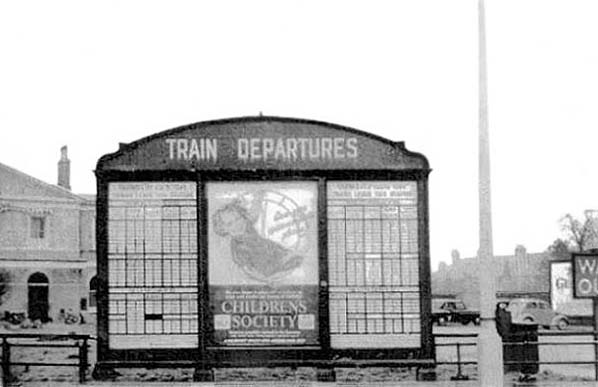
The rather grand Benn & Cronin Train Indicator board which stood outside South Town station facing onto Southtown Road. It is seen here in 1952 when the station was undergoing alterations. Unfortunately little on the board can be read but from what can be seen weekday times are towards the top and Sunday times towards the bottom. Benn & Cronin were well known for postcards, artwork and advertising. They were also responsible for many of those delightful pictures once found in railway carriage compartments, long before the days when the interior of trains went plastic, clinical and resembling of hospital corridors. The structure seen here was typical Benn & Cronin and was of a general style installed at many stations in the 1920s. They invariably included advertising space, as here, and were tailored dimensionally to suit the intended location. This was a horizontal type, others were more square whilst yet others were vertical but, as said, they followed a general style which was instantly recognisable. The board was removed soon after being photographed. A Benn & Cronin Indicator is known to have been installed inside the booking hall subsequently but it is not known if it was this board relocated or a replacement item. As many photographs show, train information was also displayed on poster boards affixed to the front of the station building but it appears that none are yet present when this view was captured. Insofar as timetable information was concerned, lack of information was something of which British Rail was rarely accused. The Children's Society is a charity still with us today.
Photo from Jim Lake collection 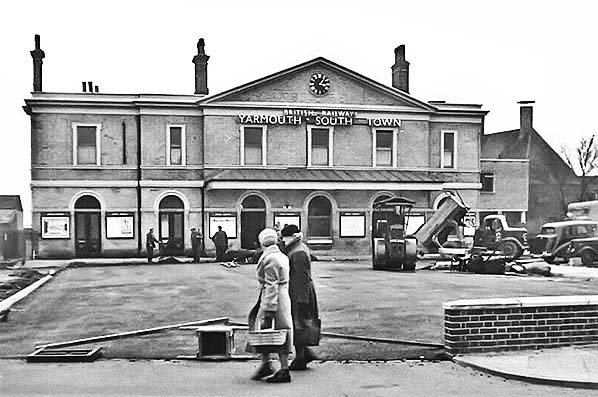 Two ladies in period clothing and with typical period shopping accoutrements amble past South Town station during the 1952 propulsion into the modern age. The garden has vanished and the forecourt is being given a nice new tarmac surface. It would appear that the boundary wall, right, is also new or at least its brickwork has been repointed and new coping stones added. The camera is looking at what had been the original ‘Way In’, now widened somewhat. The ’Way Out’ is out of view to the right, as is the impressive departures board which was to remain in situ a little while longer. On the right, and with the maltings as a backdrop, is the then new refreshments room, at this stage yet to receive its signage or indeed the metal brackets which supported it. The tracks which crossed Southtown Road to reach the goods yard are out of view to the left. On the forecourt is an Aveling - Barford diesel roller and probably, from what can be seen of it, an AD155. These were a progression of the earlier Aveling - Perkins rollers using a single cylinder Ruston engine and at one time were a familiar sight. Many were owned by local authorities and often painted in drab shades of grey. To its right is a Bedford tipper lorry; possibly an O series it could be one of several similar-looking models. To the right of the Bedford is a limousine of some description. At the time the work on the forecourt was in progress; other parts of the station were also receiving a makeover. All of this work and expense for a station which, as it transpired, was to see only another decade of regular main line trains.
Photo from Ted Burgess collection 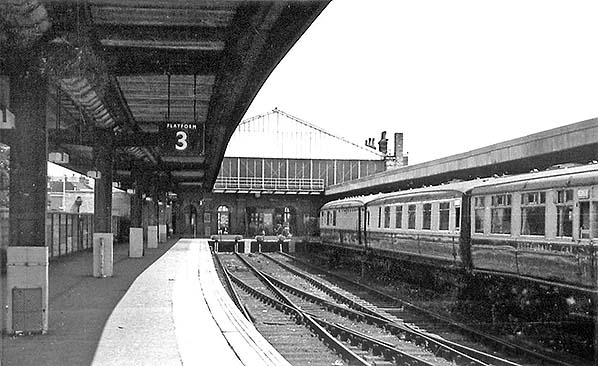 The 'business end' of South Town station on an unknown date. The removal of the train shed tells us it is after 1952 while one of the 'blood and custard' coaches is still designated as a Third. This class of rail travel was abolished in June 1956 so the photograph will probably predate this, depending upon when BR got around to applying new transfers to its rolling stock. Although by no means clear, this is one of the few views offering a largely unobstructed look at the platform side of the station building when still in use. The area behind the bufferstops and forming the front of the concourse but excluding the platform ends was marked on plans as being 'Removable Concrete Slabs' but quite when they were installed remains unclear as they appear to have predated the 1952 alterations. One possibility is that they were installed during WW2 as a repair to bomb damage; as told elsewhere, the station received a direct hit but the bomb failed to detonate. Even a bomb which fails to detonate, when dropped from an aircraft, can cause considerable damage by virtue of its mass and speed. Photographs, such as this one, looking directly at the concourse tend, due to the angle, to make concourse appear shallower than it actually was. The depth from the front of the concrete slabs to the inner wall of the booking hall was 106ft while the concourse width was 40ft. Note the suspended 'Platform 3' sign; there are two in fairly close proximity with the other being just visible near the station building. Presumably Platform 2, at least, was also so-adorned. At the bufferstop is a Gresley Brake Third. The next vehicle is another Gresley but has otherwise proved difficult to identify. It is, however, that which is still marked as being Third Class. The '3' on the nearest door is difficult to see in this view but is clear on an enlargement of the original. The nearest vehicle is a Restaurant Car to a Great Eastern Railway design. The 'business end' of South Town station on an unknown date. The removal of the train shed tells us it is after 1952 while one of the 'blood and custard' coaches is still designated as a Third. This class of rail travel was abolished in June 1956 so the photograph will probably predate this, depending upon when BR got around to applying new transfers to its rolling stock. Although by no means clear, this is one of the few views offering a largely unobstructed look at the platform side of the station building when still in use. The area behind the bufferstops and forming the front of the concourse but excluding the platform ends was marked on plans as being 'Removable Concrete Slabs' but quite when they were installed remains unclear as they appear to have predated the 1952 alterations. One possibility is that they were installed during WW2 as a repair to bomb damage; as told elsewhere, the station received a direct hit but the bomb failed to detonate. Even a bomb which fails to detonate, when dropped from an aircraft, can cause considerable damage by virtue of its mass and speed. Photographs, such as this one, looking directly at the concourse tend, due to the angle, to make concourse appear shallower than it actually was. The depth from the front of the concrete slabs to the inner wall of the booking hall was 106ft while the concourse width was 40ft. Note the suspended 'Platform 3' sign; there are two in fairly close proximity with the other being just visible near the station building. Presumably Platform 2, at least, was also so-adorned. At the bufferstop is a Gresley Brake Third. The next vehicle is another Gresley but has otherwise proved difficult to identify. It is, however, that which is still marked as being Third Class. The '3' on the nearest door is difficult to see in this view but is clear on an enlargement of the original. The nearest vehicle is a Restaurant Car to a Great Eastern Railway design.Photo from John Mann collection Click here for Yarmouth South Town Gallery 4:
 Home Page Home Page
|
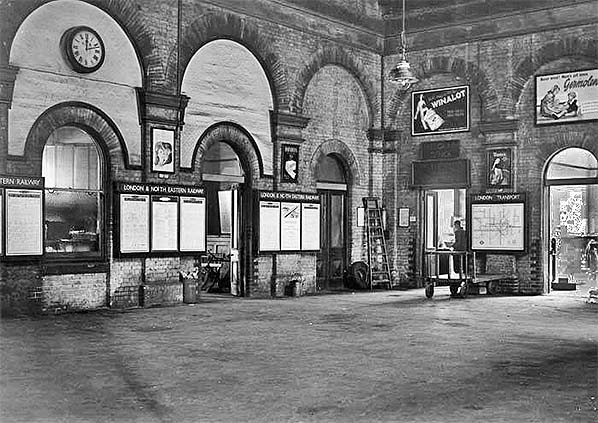 Yarmouth South Town concourse on 12 September 1950. The camera is facing towards the inner wall of the station building and the pre-1952 ticket office can be seen through the window beneath the clock. Two of the reveals appear to be sheeted over but why is not known. The open doors on the right led into the parcels and luggage offices behind which and, of course, outside the building, ran the tracks to the goods yard. These two offices remained here with the 1952 alterations, albeit with some changes to the internal layout. There was a small tobacco kiosk positioned beneath the clock and it was shown on plans of the station. The kiosk was wider than the window in the rear of the ticket office so would have obstructed the LNER poster boards. This photograph turned up subsequent to these pages being prepared and the kiosk anomaly was not known about previously, so the absence of the kiosk in this picture has proved rather a puzzle. The conclusion is therefore that the kiosk was elsewhere and was relocated at some unknown time. The pre-nationalisation poster boards bearing BR posters, as well as the generally dingy atmosphere, was quite typical of railway stations at this time. This was only five years after the end of WWII and Britain was still in a period of austerity. In addition the two-year-old British Transport Commission was a rather muddled affair still trying to find its feet and dealing with things like pre-nationalisation signage was not high on the list of priorities. Note the London Transport poster board bearing a Tube map. The map would have been the edition published by LT in January 1950. It is a pity the map is so far from the camera as it would have made an interesting perusal; the 1950 map was the first one to cease showing the proposed or partl- constructed extensions to, for example, Alexandra Palace and Bushey Heath. It did, however, continue to show the Metropolitan Line extending all the way to Aylesbury and would continue to do so until the line was electrified as far as Amersham. The gas lighting at South Town had but two years left when this photograph was taken, being replaced by electric lighting in 1952 (gas lighting on BR stations did not finally disappear until 1988 when in May of that year those at Ilkley hissed for the final time. Other late survivors were Emerson Park, on the Romford - Upminster line; Selsdon on the Elmers End – Sanderstead line; and Brading, IoW). Among the advertisements on view at South Town in 1950 were Winalot and Germolene, both products being still available today.
Yarmouth South Town concourse on 12 September 1950. The camera is facing towards the inner wall of the station building and the pre-1952 ticket office can be seen through the window beneath the clock. Two of the reveals appear to be sheeted over but why is not known. The open doors on the right led into the parcels and luggage offices behind which and, of course, outside the building, ran the tracks to the goods yard. These two offices remained here with the 1952 alterations, albeit with some changes to the internal layout. There was a small tobacco kiosk positioned beneath the clock and it was shown on plans of the station. The kiosk was wider than the window in the rear of the ticket office so would have obstructed the LNER poster boards. This photograph turned up subsequent to these pages being prepared and the kiosk anomaly was not known about previously, so the absence of the kiosk in this picture has proved rather a puzzle. The conclusion is therefore that the kiosk was elsewhere and was relocated at some unknown time. The pre-nationalisation poster boards bearing BR posters, as well as the generally dingy atmosphere, was quite typical of railway stations at this time. This was only five years after the end of WWII and Britain was still in a period of austerity. In addition the two-year-old British Transport Commission was a rather muddled affair still trying to find its feet and dealing with things like pre-nationalisation signage was not high on the list of priorities. Note the London Transport poster board bearing a Tube map. The map would have been the edition published by LT in January 1950. It is a pity the map is so far from the camera as it would have made an interesting perusal; the 1950 map was the first one to cease showing the proposed or partl- constructed extensions to, for example, Alexandra Palace and Bushey Heath. It did, however, continue to show the Metropolitan Line extending all the way to Aylesbury and would continue to do so until the line was electrified as far as Amersham. The gas lighting at South Town had but two years left when this photograph was taken, being replaced by electric lighting in 1952 (gas lighting on BR stations did not finally disappear until 1988 when in May of that year those at Ilkley hissed for the final time. Other late survivors were Emerson Park, on the Romford - Upminster line; Selsdon on the Elmers End – Sanderstead line; and Brading, IoW). Among the advertisements on view at South Town in 1950 were Winalot and Germolene, both products being still available today.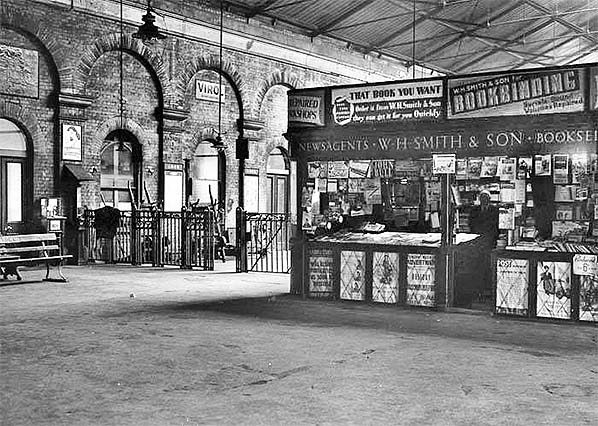 Yarmouth South Town concourse on 12 September 1950, this time looking south-west from the concourse towards the ticket barriers. Note the rather lower-hung gas lights at the barrier area. LNER poster boards bearing BR posters are again visible. Most of the W H Smith bookstall can be seen; most of its offerings appearing to be newspapers and magazines, rather than books, which was quite typical of these railway station stalls which catered largely for passengers wanting something to pass the time with on train journeys and then leave on the seats or luggage racks. The firm dates back to 1792 when Mr & Mrs Henry Walton Smith ran a news vending business in London. Following their deaths sometime in the early nineteenth century their youngest son, William Henry Smith, took over the business and thus the W H Smith business still with us today was born. The company's first venture into vending at railway stations occurred in 1848 at Euston. The section of roof seen here had been repaired following damage during WWII, but in 1952 it was to disappear altogether from the point roughly where the Virol advertisement is positioned and the remaining section over the concourse was renewed. A short length of the wall was also lowered along the section overlooking the platforms but otherwise remained unchanged.
Yarmouth South Town concourse on 12 September 1950, this time looking south-west from the concourse towards the ticket barriers. Note the rather lower-hung gas lights at the barrier area. LNER poster boards bearing BR posters are again visible. Most of the W H Smith bookstall can be seen; most of its offerings appearing to be newspapers and magazines, rather than books, which was quite typical of these railway station stalls which catered largely for passengers wanting something to pass the time with on train journeys and then leave on the seats or luggage racks. The firm dates back to 1792 when Mr & Mrs Henry Walton Smith ran a news vending business in London. Following their deaths sometime in the early nineteenth century their youngest son, William Henry Smith, took over the business and thus the W H Smith business still with us today was born. The company's first venture into vending at railway stations occurred in 1848 at Euston. The section of roof seen here had been repaired following damage during WWII, but in 1952 it was to disappear altogether from the point roughly where the Virol advertisement is positioned and the remaining section over the concourse was renewed. A short length of the wall was also lowered along the section overlooking the platforms but otherwise remained unchanged.